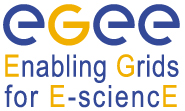Speakers
Describe the added value of the grid for your activity, or the value your tool or service adds for other grid users. This should include the scale of the activity and of the potential user community, and the relevance for other scientific or business applications.
It’s well-known that the Monte Carlo codes are suitable for running on the Grid because of their easy parallelization. To the date, FAFNER2 has been usually run at CIEMAT by means of a batch mode on a shared memory of a Cray architecture, but its grid-version does on MPI. From this point of view, FAFNER2 would not only mean a new code ported to the Grid, but it opens a new strategy for the fusion community. Since it deals with the heating method for the fusion devices, it is able to be coupled to the ion kinetic transport code ISDEP, in a way that the outputs from FAFNER2 will be the input for the latter. Such a complex workflow is of interest for both fusion and grid communities. Into this framework, the FAFNER2 porting to the grid is the first step of a more ambitious work
Report on the impact of the activity, tool or service. This should include a description of how grid technology enabled or enhanced the result, or how you have enabled or enhanced the infrastructure for other users.
As it has been aforementioned, FAFNER2 is of interest for the fusion community so it is expected to be of impact. In addition, a wider range of physicist specialised in this field are now users of the Grid in projects such as EGEE-II, EGEE-III or EUFORIA and the future ITER tokamak will be built with some of the Neutral Beam Injector techniques. The performance of FAFNER2 on the Grid enhances their results because of the greater number of particles that can be calculated in a reasonable time. It is expected to be run in a sequence with a transport code in a future; first, adapted to the TJ-II stellarator and, later, to different devices by changing the 3D lattice parameters
Describe the activity, tool or service using or enhancing the EGEE infrastructure or results. A high-level description is needed here (Neither a detailed specialist report nor a list of references is required).
FAFNER2, a 3D code adapted to the TJ-II halical axis stellarator from the original one developed by Lister et al. at Max Planck IPP, simulates by Monte Carlo methods the Neutral Beam Injection technology (the main heating method for most of the fusion experiments worldwide). It deals with neutral atoms which are able to overcome the confining magnetic field of a tokamak or a stellarator and are ionised in the plasma via collisions with ions and electrons thus heating and feeding the plasma




